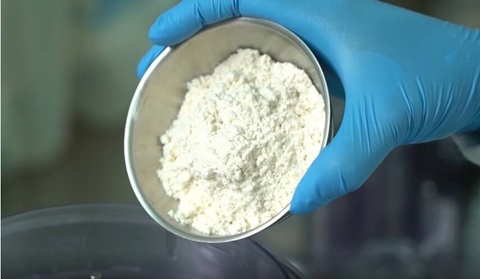

Plant-based chicken meat
Background
Ve-Chick, a plant-based protein chicken meat, is a product derived from the research team’s intention to use fiber, a by-product of the extraction of pectin from pomelo peels. This fiber is incorporated into various food products, including plant-based foods, to enhance their textures. The first product using this concept is the “nugget” prototype. At the same time, plant-based foods are experiencing continuous growth in the market. Therefore, the research team has the idea of turning this research work into commercial products in response to this market trend.
The research team has explored alternative staples readily available, such as legumes like soybeans, peas, and mung beans. Its ultimate goal is to modify these ingredients’ texture and composition to imitate those of chicken. Interestingly, it was discovered that various nuts exhibited distinct textures, primarily influenced by their amino acid profiles. Soybeans emerged as a particularly promising ingredient due to their cost-effectiveness. Notably, soybeans possess a robust protein structure, which, when combined with gluten, enhances the artificial meat’s resilience to freezing and thawing. Beyond nuts, there are other essential components like binding agents and fibers, some of which have been registered as proprietary secrets by the MTEC research team. These remarkable attributes make these ingredients versatile for the development of various products, catering to the specific needs of manufacturers.
Goals
1. To develop premix plant-based, gluten-free chicken powder products.
2. To develop pre-cooked semi-process soy protein chicken meat products.
What did the research team do?
Using a cost-effective blending method, the research team achieved a fibrous structure through a novel structural arrangement process. This process does not require specialized tools or machinery; it operates at the macro level, meaning it does not disrupt protein structures or delve into the molecular level. Instead, it attains the required structure by blending various components and induces phase separation to the formation of organized layers. This results in a final product with a texture closely resembling chicken meat.


Research results
The distinct feature of Ve-Chick is that it offers two product forms:
(1) pre-cooked, gluten-free chicken meat and
(2) semi-processed, pre-cooked chicken meat.
The instant chicken meat powder products are sealed in moisture-proof and odor-resistant packaging. They are readily transportable and suitable for international export, with a one-year shelf life at room temperature. The powdered product resembles cake flour and can be mixed with water and oil to create a chicken-like texture. It can then be shaped or placed into molds to form pieces of chicken meat. Subsequently, they can be sliced into portions and seasoned, thus ready for consumption. This product caters to a wide range of consumers, including those with gluten allergies, and is well-suited for use in restaurant and hotel kitchens.
These instant chicken-like soy protein pieces are distributed as a direct substitute for conventional chicken meat products. They come in two forms: frozen pieces and ready-to-eat options. Frozen meats can be used in various dishes when cooked. The pre-cooked ones can be quickly reheated using an air fryer or warmed up without any alteration in texture for immediate consumption.
Research status
The Ve-Chick technology has been transferred to three companies: Praya Quality Co., Ltd., Green Spoons Co., Ltd., and B.I.G. Natural Green Co., Ltd.
Outlook
1. To develop Ve-Chick, both packaged in retort pouches and cans, into a ready-to-eat product that utilizes retort sterilization, thus allowing for an extended shelf life at room temperature.
2. To study the effect of extrusion, a thermomechanical process, intended to transform protein texture from a globular into a linear form and arrange its structures to closely imitate animal meat fibers, resulting in a more meat-like surface.
3. To acquire knowledge about how plant-based protein structure influences digestion and the absorption of nutrients in simulated digestive systems for adults and older people.
Research team
Dr.Kamolwan Israkarn, Dr.Chaiwut Gamonpilas, Dr.Nispa Seetapan, Dr.Pawadee Methacanon, Dr.Asira Fuongfuchat, Rattana Yooberg
Contact
Chanit Wanikanukul
Industrial and Business Liaison Section
Business Development Division
Tel. +66 2564 6500 ext. 4788
Email: chanitw@mtec.or.th
